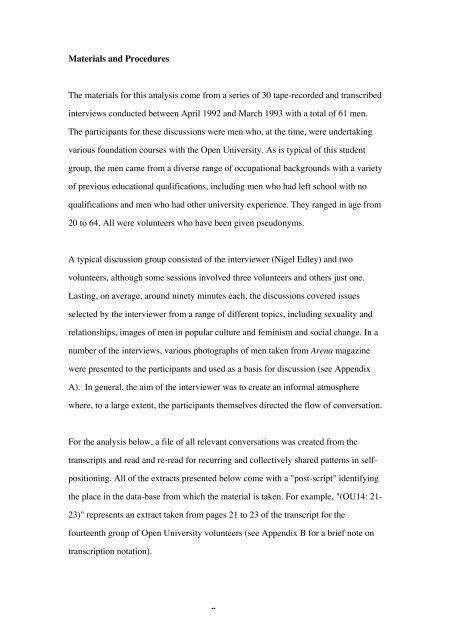Negotiating Hegemonic Masculinity: Imaginary ... - UCSB Linguistics
Negotiating Hegemonic Masculinity: Imaginary ... - UCSB Linguistics
Negotiating Hegemonic Masculinity: Imaginary ... - UCSB Linguistics
Create successful ePaper yourself
Turn your PDF publications into a flip-book with our unique Google optimized e-Paper software.
Materials and Procedures<br />
The materials for this analysis come from a series of 30 tape-recorded and transcribed<br />
interviews conducted between April 1992 and March 1993 with a total of 61 men.<br />
The participants for these discussions were men who, at the time, were undertaking<br />
various foundation courses with the Open University. As is typical of this student<br />
group, the men came from a diverse range of occupational backgrounds with a variety<br />
of previous educational qualifications, including men who had left school with no<br />
qualifications and men who had other university experience. They ranged in age from<br />
20 to 64. All were volunteers who have been given pseudonyms.<br />
A typical discussion group consisted of the interviewer (Nigel Edley) and two<br />
volunteers, although some sessions involved three volunteers and others just one.<br />
Lasting, on average, around ninety minutes each, the discussions covered issues<br />
selected by the interviewer from a range of different topics, including sexuality and<br />
relationships, images of men in popular culture and feminism and social change. In a<br />
number of the interviews, various photographs of men taken from Arena magazine<br />
were presented to the participants and used as a basis for discussion (see Appendix<br />
A). In general, the aim of the interviewer was to create an informal atmosphere<br />
where, to a large extent, the participants themselves directed the flow of conversation.<br />
For the analysis below, a file of all relevant conversations was created from the<br />
transcripts and read and re-read for recurring and collectively shared patterns in self-<br />
positioning. All of the extracts presented below come with a "post-script" identifying<br />
the place in the data-base from which the material is taken. For example, "(OU14: 21-<br />
23)" represents an extract taken from pages 21 to 23 of the transcript for the<br />
fourteenth group of Open University volunteers (see Appendix B for a brief note on<br />
transcription notation).<br />
8
















